Catalogue 2023-2024
Below, browse the 2023-2024 Rencontres Internationales catalogue, or search the archives of the works presented since 2004. New video clips are routinely posted and the images and text are regularly updated.


Paulius Anicas
Charming Habits
Fiction expérimentale | 4k | couleur | 20:20 | Lituanie | 2022
Poet at work: daydreams, nightmares and writings.
Paulius Ani?as, born in Vilnius, Lithuania. Graduated contemporary sculpture BA in Vilnius Academy of Arts.
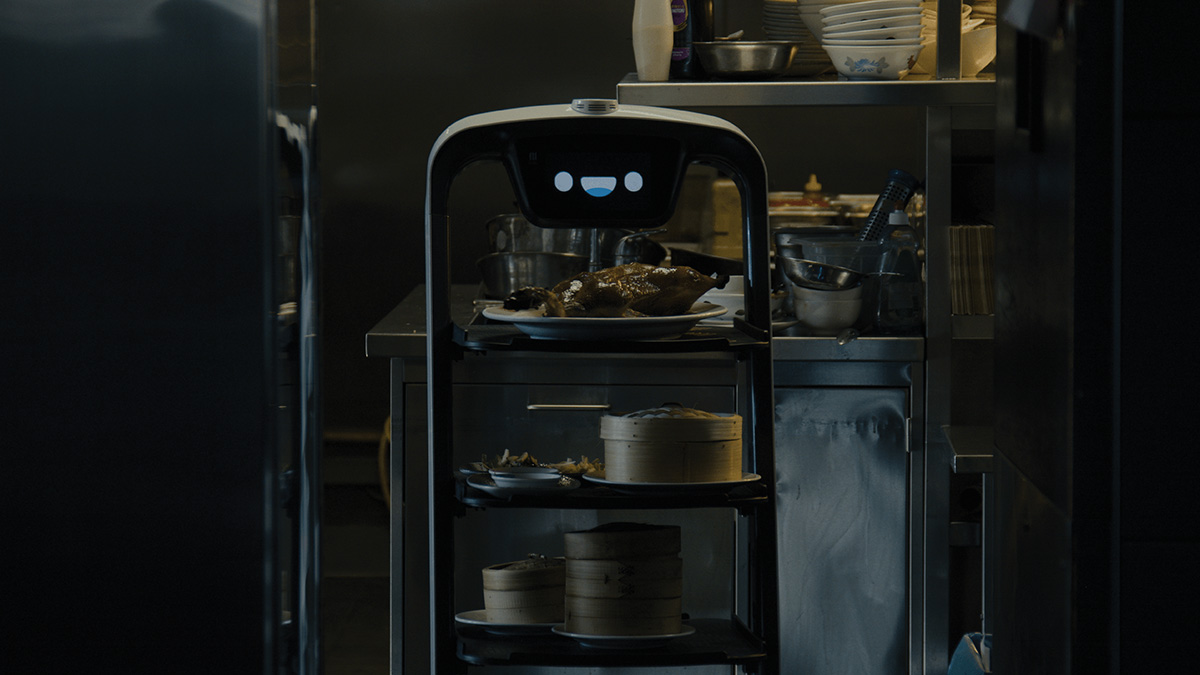

Misho Antadze, -
Metabolism
Doc. expérimental | 4k | couleur | 12:0 | Georgie, Pays-Bas | 2023
Robots work on a dairy farm. They milk the cows, clean their dung, and massage them. Meanwhile, human beings are absent. In a restaurant, robot waiters bus food back-and-forth, ignored completely by their human colleagues. An engineer revives an old robotic arm for his children. With a curious, observational gaze, Metabolism looks at technology, animals, and labor.
Misho Antadze is a filmmaker and artistic researcher from Tbilisi, Georgia, born in 1993 He holds a BFA in Film/Video from CalArts and an MA in Artistic Research through Cinema from the Netherlands Film Academy. As a practitioner and researcher, his interests include the meeting and departure points of cinema and history, as well as animal and non-human perspectives. His works have screened at International Film Festival Rotterdam, Ann Arbor Film Festival, DocLisboa and Full Frame Film Festival, amongst many others. The Harvest was awarded at Jeonju International Film Festival and at Palic European Film Festival and was screened online on e-Flux.
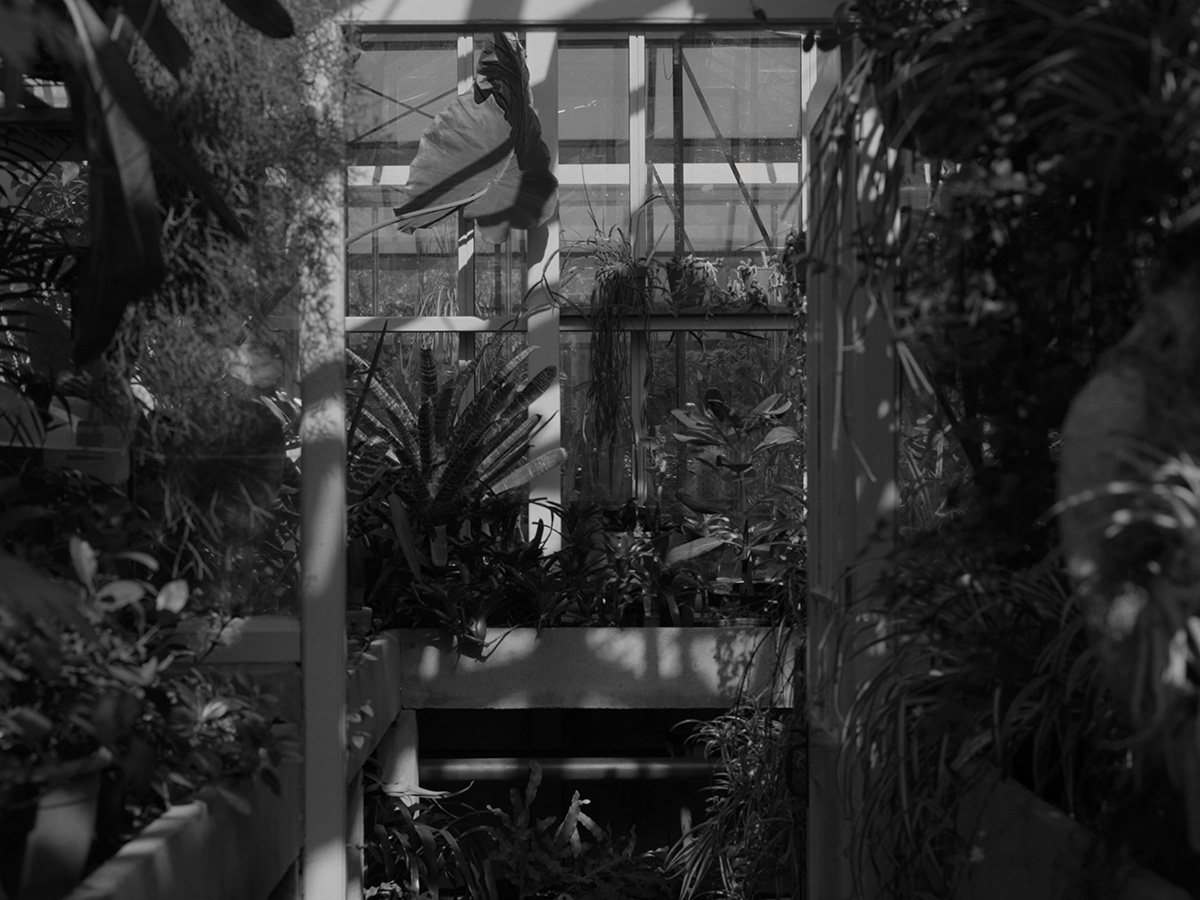

Sol Archer
On a bare rock by the ocean you will never hear anything but birds whose cries blend with the sound of winds
Film expérimental | 4k | noir et blanc | 15:20 | Royaume-Uni, Pays-Bas | 2022
Brief Synopsis The tropical greenhouse is the pinnacle of the construction of nature as spectacle, a montage of discontinuous seasons, climates, and ecosystems, narrating ecological travelogues for the spectator passing through the hard cut of the glass door. Within, ‘nature’ is a collage inherited from the colonial period, an image practice, emergent contemporaneously with the nascent technologies of photography, and ultimately the bricolage strategy of cinema, and calling for specific relations of care and ecology building. In this film volunteers at a colonial era greenhouse in a small Dutch village collaborate to produce a sonic environment, soundtracking their maintenance labour with vocal re-creations of animal and bird calls, transcribed in the 1820s as western musical notation by Hercule Florence, the Brazilian ‘isolate inventor of photography’. Detailed synopsis This film is a work on the construction of ‘nature’ as image practice, emergent in the colonial period contemporaneously with the nascent technologies of photography, recording, and ultimately the bricolage strategy of cinema. Volunteers at a colonial era greenhouse in a small Dutch village soundtrack their labour maintaining a tropical spectacle with vocal re-creations of animal calls, transcribed in the 1820s in Brazil by Hercule Florence, the Brazilian ‘isolate inventor of photography’, whose writings pre-sage the spectacle and compression of space and time of cinematic form. The tropical greenhouse is the pinnacle of the construction of nature as spectacle, a montage of discontinuous seasons, climates, and ecosystems, narrating ecological travelogues for the spectator passing through the hard cut of the glass door. Within, ‘nature’ is a collage inherited from the colonial period, that has left us with composite ecologies, gardens, parks, and farms, montages of ecosystems and climates forming relations according to aesthetic, cultural, and commercial values and calling for specific relations of care. In the 1820s, while on the Langsdorff expedition into the interior of Brazil, Florence, employed to illustrate scientific and anthropological encounters, developed a new method for transcribing animal calls as European style musical notation. His fragments of sound were sent to the scientific institutes of the Metropole, but, the expedition ending in sickness, unrecognised. In the mid-1800s, with printing outlawed in Brazil, Florence developed a photographic process, and a rudimentary camera 15 years before Daguerre, with the aim of reproducing and publishing his work. Bound together in his writing, and in his sound and image practice ‘nature’ emerges in the 1830s as construct, as an image making spectacle, a quasi-cinematic re-assemblage of isolated elements into a sensory, and, above all aesthetic framework. “Gardens, like dreams, would seem to lose their innocence in analysis. However, dreams, like gardens, were never disconnected from the every day damage, responsibilities, and contaminations of the seemingly more “real” spaces of our lives. The dried plant specimen bound in the monograph with coloured plants may lead us from botany to rivalry and the problems of power and desire, but, in that path, the dream of the botanical monograph also shows us that the transports of pants and passionate attachments to flora hold in their train an inescapable history of the effects of imperium. Though we are implicated in the history of the dream of the botanical monograph, we cannot just disavow the botanical, claiming that it has no place, especially if we are to have a place at all in this global environment not necessarily of our own making. The problem then becomes how to re landscape the overdetermined “garden” we may most want to displace.” Jill H. Casid, Sowing Empore, Landscape and Colonisation.
Sol Archer (1983) is a Netherlands based artist working through collaboration with professional and non-professional groups, considering the encounter as a space of production. Frequently working with video, Sol is focussed on ways individuals and communities constitute themselves through their association with collective cultural activity, and how identities and histories entwine through the performance of cultural attachment. This extends into a pedagogical practice on structures and systematising group environments focussed on self reflexive film-making practices and the legacy of collaborative film practice. Sols work has been exhibited widely, including in the Sydney Biennial, Sydney, AU; Rozenstraat, Amsterdam, Golden Thread, Belfast, Northern Ireland, NL; Le Crac19, Montbeliard, FR; Index Foundation, Stockholm, SE; TULCA, Galway, IR; Le Lieu Unique, Nantes, FR; MuKHA, Antwerp, BE; and more.
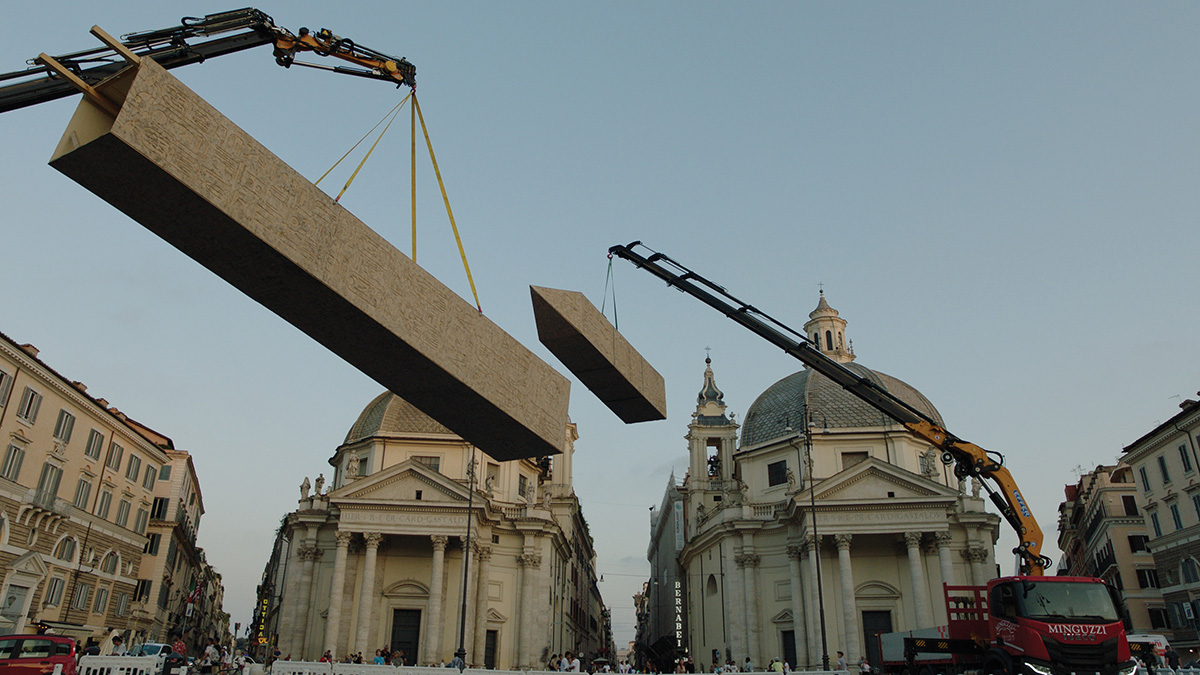

Iván Argote
Levitate
Doc. expérimental | 0 | couleur | 24:0 | France, Italie | 2022
What do monuments want, do, and stand for in our memories and public spaces? Levitate, a new film by Colombian artist Iván Argote, questions the histories, functions and possible futures of colonial icons that still today define the identity of modern European cities. In what the artist calls three anticipatory actions, organized as grand-scale performances in the centers of Rome, Madrid, and Paris, we are confronted with three emblems of control and domination that still exert, undisturbed, their symbolic power from atop their pedestals. The Flaminian obelisk in the Piazza del Popolo, which came to Rome at the behest of Emperor Agustus in 10 B.C.; the statue of Christopher Columbus erected to commemorate the day of the "discovery" of the Americas; and the statue of French military officer and colonial administrator Joseph Gallieni, are suspended, displaced from their position as vertical markers of power and tools for propaganda. Their disruption, albeit ephemeral, immediately opens up a space of public discussion.
Iván Argote is a Colombian artist and film director based in Paris. Through his sculptures, installations, films and interventions, he questions our Relation with others, with power structures and belief systems. He develops strategies based on tenderness, affect and humor through which he generates critical approaches to dominant historical narratives. In his interventions on monuments, large-scale ephemeral and permanent public artworks, Iván Argote proposes new symbolic and political uses of public space. Iván Argote studied graphic design, photography and new media at the Universidad Nacional de Colombia in Bogotá and holds an mfa from the Ecole Nationale Supérieure des Beaux-art (Ensba) in Paris. His work has been the subject of solo exhibitions at Albarrán Bourdais Gallery (Madrid, 2022), Dortmunder Kunstverein (Dortmund, 2021), Perrotin Gallery (New York, 2021 & Paris, 2018), Artpace (San Antonio, TX, 2021), Asu Museum (Phoenix, 2019), Malba (Buenos Aires, 2018), Museo Universitario Del Chopo (Mexico City, 2017), Galeria Vermelho (Sao Paulo, 2017), Palais De Tokyo (Paris, 2013) And Ca2m (Madrid, 2012). Works by the artist are included in the permanent collections of numerous prestigious institutions worldwide, including the Guggenheim Museum (New York, Us); Centre Pompidou (Paris, France); Asu Art Museum (Phoenix, Us); Cisneros Fontanals Art Foundation (Miami, Us); Colección De Arte Del Banco De La República (Bogotá, Colombia); Kadist (San Francisco, Us); Macba (Barcelona, Spain).
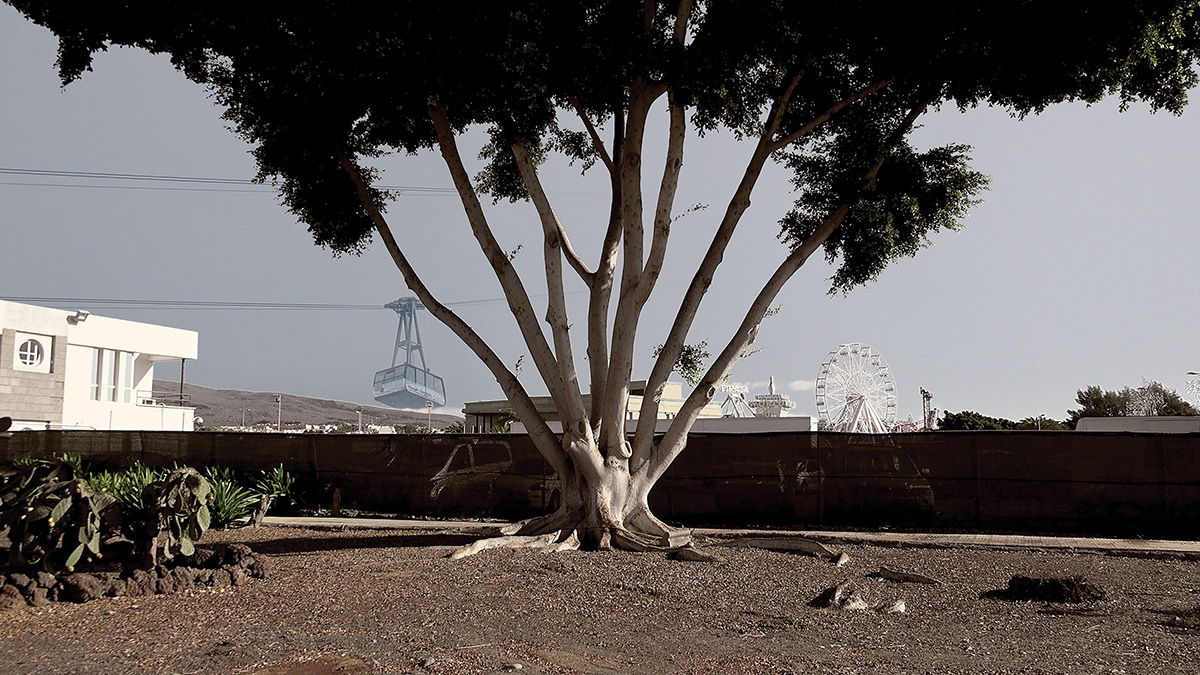

Carsten Aschmann
Sonnenland Nr. 62
Film expérimental | 4k | couleur | 23:50 | Allemagne | 2022
Landing approach to an island. The camera observes and traverses public space, on foot and in the air. Shots from the past and future intersect the vacation images. While filmmaker Aschmann speaks unadorned about his difficulty in finishing a film, we hear voice messages left by a colleague, eloquent and satirically pointed - on the subject of film and their ambitions. In a dune landscape, naked people stand and wait for their fortune.
Carsten Aschmann is a freelance filmmaker, producer, editor and curator of film series, for festivals and seminars. From 1993 - 97 he set up the film workshop Sector 16. In 2003 he created the label "Hula-Offline". Since 2006 also producer for documentaries and active as scriptwriter. He lives and works in Hanover. Studied philosophy and German language and literature, 1987 - 1988 Studied fine arts at the HBK-Braunschweig film class, 1989 - 1996 Master student of the film class with Prof. Birgit Hein
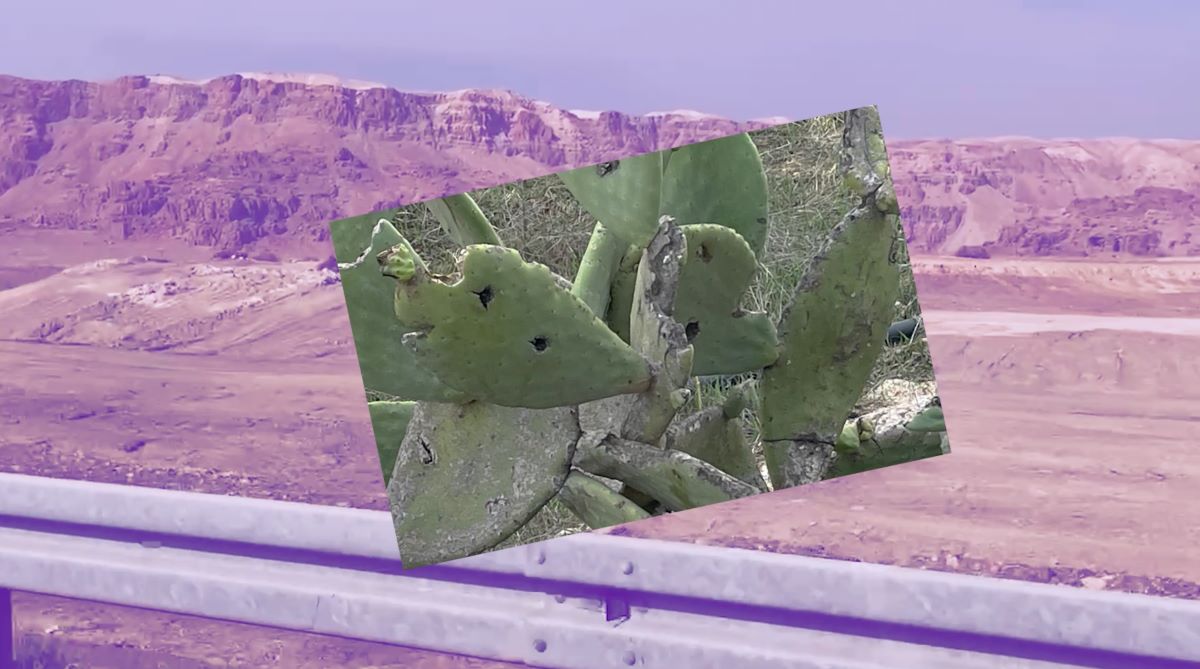

Oreet Ashery
Selfish Road
Doc. expérimental | hdv | couleur | 30:48 | Royaume-Uni | 2022
Selfish Road (2022) A 30-minute film by artist and filmmaker Oreet Ashery. Journeying through their homeland and recalling autobiographical memories along the way, Ashery observes how both senses of belonging have and continue to fuse with the vertiginous and winding flows of nation-building, infrastructure and land use. Turning a camera onto the contested land in and around Jerusalem, Selfish Road draws upon the genres of science-fiction, stand-up comedy, the family photo album, and the implicit privilege of the slacker road movie. The film reveals a composite portrait of a rapidly changing landscape: roads collapse into sinkholes, diseased cacti line highways, and location-monitoring apps map circuitous routes to flag “high risk” and “prohibited” areas. This episodic reflection of space and place attempts to work through the paradox: How can you own something that is stolen? Selfish Road depicts a contradictory environment of industrial extraction obscured by spiritual wellness practices. With anger, grief, hope, and resistance, it dreams of material ecological visions for indigenous life away from settler occupation and seeks out an ethics in and beyond the beauty of the region. Commissioned by A KW Production Series. Text by Mason Lever-Yap
Oreet Ashery is a visual artist and an experimental film maker whose practice navigates established, institutional and grassroots contexts. The work engages with bodies, community, worldbuilding, autoethnography, Thanatos, gender and technology. Ashery’s practice manifests through distinct multiplatform projects that span video, 2D image-making, performance and assemblage. Characterised by the use of speculative fiction and humour, the work often occupies utopian, discursive and incongruous spaces. Ashery was a Turner Bursary recipient in 2020 (replacing the Turner Prize during the pandemic) and won the prestigious Jarman Film Award in 2017 for her web-series Revisiting Genesis, interfacing documentary and fiction and looking at the emergent field of digital death. In this context Ashery published her book How We Die Is How We Live Only More So, Mousse Publishing, 2019. Ashery is Professor of Contemporary Art at the Ruskin School of Art, University of Oxford


Tekla Aslanishvili
A State in a State
Doc. expérimental | 0 | couleur et n&b | 47:0 | Georgie, Arménie | 2022
"A State in a State" is an experimental documentary film that follows the construction, disruption, and fragmentation of railroads in the South Caucasus and Caspian regions. It examines railways as the technical materialization of the fragile political borders that have re-emerged after the collapse of the Soviet Union. Revolving around the scenes of delay and waiting that constitute cargo mobility, the film reads the optimistic narratives about the New Silk Road against the grain. It observes how the iron foundation of connectivity can be used as a weapon of exclusion and geopolitical sabotage. Dotting the same lines, other forms of sabotage are deployed by workers to disrupt the political violence. Looking at historic and current practices of resistance, "A State in a State" explores the potential of railroads for building a different infrastructural consciousness and the lasting, transnational kinship among the people who live and work around them.
Tekla Aslanishvili (Born in Tbilisi in 1988) is an artist, filmmaker, and essayist based between Berlin and Tbilisi. She completed her studies at the Tbilisi State Academy of Arts in 2009 and holds an MFA from the Berlin University of the Arts in Experimental Film and New Media Art. Her experimental documentary films, texts, and installations emerge at the intersection of design, history, and geopolitics. They explore the shifting fault lines between governments, people, and their land through the lens of large-scale transit and energy infrastructure projects. Tekla is a 2018–2019 Digital Earth fellow, the nominee for Ars-Viva Art prize 2021 and the recipient of the Han Nefkens Foundation - Fundació Antoni Tàpies Video Art Production Award 2020. Currently, she is a postgraduate fellow at the Graduate School of the University of the Arts Berlin.


Sina Ataeian
Sand Storm
Vidéo | 4k | couleur | 5:0 | Allemagne, Iran | 2022
I come from Ahvaz in southern Iran, the capital of the oil industry. As a child I played football outside in more than 50°C. Ahvaz was officially the hottest city on Earth. The city was just 80km away from the frontline of the Iran-Iraq war. According to independent reports, Saddam Hussein had used chemical weapons 387 times in that region during eight years of war. The chemicals were made in the Soviet Union, East and West Germany. The mustard gas killed combatants and civilians alike and remained in the soil. After the war, and due to global warming, the city slowly became hotter and hotter. The chemically poisoned soil slowly dried out. The wind came and swept the dust up into the air. The fine dust pollution in Ahvaz is 52 times higher than the maximum tolerable limit for one’s health. Around 290 days a year there is a thick haze mixed with chemicals called ‘Sand Storms.’ Ahvaz then officially became the number one in yet another area: The most polluted city on earth. The moment the oil is depleted Ahvaz will become a ghost town. A big wave of climate migrants. A tsunami of cancer! For most people, an apocalyptic environmental catastrophe is still something that is coming in the future. For us, people from Ahvaz, it has already happened.
Sina Ataeian Dena is an Iranian-German filmmaker and artist. Sina lectures at the national university of film and television dffb, UdK University of arts Berlin, and Filmuniversität Potsdam. His video arts and photographs were exhibited at prestigious contemporary art museums such as Hamburger Bahnhof, Villa Merkel, Künstlerhaus Bethanien, Kunsthalle Baden-Baden. In 2015, his debut feature film “Paradise” was nominated for Golden Leopard in the main competition of Locarno Film Festival, and won two awards, Ecumenical Church Award and Art Peace Award, among many other festival attendees and awards around the world. In 2016, he was awarded a scholarship from Goethe Institut Villa Tarabya Istanbul. In 2018 he exhibited his first video works in the modern and contemporary art museum Villa Merkel together with Francis Alys and !Mediengruppe Bitnik. Sina was Dramaturge and associate producer of the documentary “Seven winters in Tehran” Steffi Niederzoll which won Best film of Perspective section and the Heinrich Böll prize Berlinale 2023, F-ACT award at CPH:DOX Copenhagen among ongoing festival attendees and further awards.


Lin Htet Aung
Seeking Wombs For Rebirths
Fiction expérimentale | mov | noir et blanc | 24:44 | Myanmar | 2021
A boy went to a town. He went to find his next life.
Lin Htet Aung is a 98 born self-learned filmmaker and time based media artist based in Myanmar. In his earlier days, he wrote avant-garde poems and published underground poetry books. He started making short films in 2017. In 2020, his experimental short film “Estate” won “Silver Screen Award – Best Director” in Southeast Asian Short Film Competition at 31st Singapore International Film Festival SGIFF (2020). In 2023, his latest short film won the Principi Award at Lago Film Fest (Italy). His short films have been selected at International Film Festival Rotterdam (IFFR), Internationale Kurzfilmtage Oberhausen, LINOLEUM Contemporary Animation and Media Art Festival, Kurzfilm Festival Hamburg, Ruang Rantau Exhibition (United States), Ecological Futurisms (UK) and so on. He is interested in the concept of time, duration, history, archiving and projection.He explores all kinds of mediums, especially videos, photos, paintings and texts. He is always seeking the magic of changing details in his environment through time and composes them as dysfunctional stories in his artworks.


Georgy Bagdasarov, Alexandra Morales
Pro(s)thetic Dialogues
Doc. expérimental | mp4 | couleur | 21:39 | Arménie, Tchèque (Rép.) | 2022
Pro(s)thetic dialogues is more like a recording of a theatre performance playing out on a computer desktop. Here the human operator creates the conditions for exploring the performativity of a philosophical zombie pieced together from neural networks. The operator/stage technician merely directs the flow of mathematical operations pretending thought and creates a space in which the philosophical discourses are dissolved
Since 2013 Alexandra Moralesova and Georgy Bagdasarov form a filming and experimenting duo Labodoble. We run an artistic and curatorial platform under the same name. We mainly focus on photo-chemical experimental film processes but we are interested in other kinds of media practices. We like to question media and to reshape the relation of machine-operator into machine-performer. We merge technical skills with media theory and philosophy. We do films, performances, installations and workshops.


Christian Bagnat, Elvira Sánchez Poxon
Tembiapo Pyharegua
Doc. expérimental | hdv | couleur et n&b | 120:0 | Argentine, Espagne | 2022
Tembiapo Pyharegua (Night Work) is a cinematographic chronicle that follows the life of a Paraguayan Guarani-speaking community that settled in Cuenca, Spain. The title refers to those nights where the impossible is dreamed and lived, that time of life between working hours. That is where we stop and observe how they recover their time. And how they spend their leisure hours. During those nights they name the things they are willing to do when they return to their country. Desires, dreams, future projects: every day they say them out loud, as if it were a spell. A record of this future is slowly being made, night by night.
Christian Bagnat. Argentina 1971. Studied Art and later Film. Night Work, first feature film co-directed with Elvira Sánchez Poxon. It’s filmed in Cuenca over seven years, using a particular method of work that reflects on the changes and events that occur in a small town. He works creating a film archive about the Latin diaspora in Spain. Elvira Sánchez Poxon Madrid 1977. She studied Fine Arts at the UCM and developed works in the field of painting and experimental sound stories. In the meantime, she studied film, collaborating regularly with Christian Bagnat. They co-directed the short film Pablo and Night Work is their first feature film.


Ben Balcom
Looking Backward
Doc. expérimental | 16mm | couleur et n&b | 10:0 | USA | 2022
Filmed on the former grounds of Black Mountain College, Looking Backward is a brief elegy to the legacy of a utopian college and other impossible projects.
Ben Balcom is a filmmaker and educator currently living and working in Milwaukee, Wisconsin. He is an assistant professor at the University of Wisconsin-Milwaukee and is the co-founder and programmer of Microlights Cinema, an artist-run microcinema which has been operating since 2013 and has hosted artists from around the world. Recently, his films have taken a lyrical approach to documenting the spaces and legacies of now-defunct experimental schools. Prior to that he made a series of introspective landscape films that engaged with Milwaukee’s progressive political past and contemporary anxieties about the future. Earlier films used abstraction to explore the tensions between perception and communication, with a reflexive attention on the medium itself. These films have been exhibited around the world at venues and festivals such as The Museum of Moving Image, European Media Arts Festival, International Film Festival Rotterdam, IndieLisboa, Media City Film Festival, Alchemy Film, and Slamdance. The films have received awards at Onion City Film Festival, Athens International Film & Video Festival, and Ann Arbor Film Festival. Recently, Balcom was a fellow at the Center for 21st Century Studies at UW-Milwaukee.


Maddi Barber, June Crespo
CORE
Film expérimental | mov | couleur | 21:22 | Espagne | 2022
Someone is sleeping. A conveyor belt moves stones in an underground place. The stones fall through a hole in the shape of a mouth. Some hands go through a piece of concrete. Someone operates a knob that crushes the stone. In CORE, we document the different states through which the material passes: stone, dust, liquid and solid. Moving between the surface of things and underneath them, we interweave two apparently distant processes: hands traversing and manipulating cement sculptures and the process of extracting and transforming stones in a quarry. An encounter and friction between materials that is in turn the result of the meeting and negotiation of two languages, the sculptural and the cinematographic.
JUNE BIO June Crespo (Pamplona 1982) graduated in Fine Arts from the University of the Basque Country in 2005 and participated in the De Ateliers residency programme (Amsterdam 2015-2017). Her solo exhibitions include: entre alguien y algo (2022) and Ser dos (2017) at CarrerasMugica gallery, Bilbao; Helmets (2020) at Artium, Vitoria-Gasteiz; Voy, sí (2020) Heinrich Ehrhardt gallery, Madrid and No Osso (2019) at Uma Certa Falta de Coêrencia, Oporto. She has recently participated in group exhibitions such as: The Milk of Dreams, Venice Biennale 2022; Fata Morgana, Jeu de Paume (Paris) or El sentido de la Escultura at the Miró Foundation (Barcelona). MADDI BIO Maddi Barber (Valle de Arce, 1988) has a degree in Audiovisual Communication and an MA in Visual Anthropology from the University of Manchester. Her work has been shown at festivals such as Visions du Réel, FidMarseille, San Sebastian (Zabaltegi), Curtocircuito, Zinebi, Ji.hlava, Porto Post Doc and Las Palmas, among others. They have also been exhibited in museums and centres such as La Panera, Artium and the Oteiza Museum. She is currently working on the development of his first feature film, "Claros de bosque".
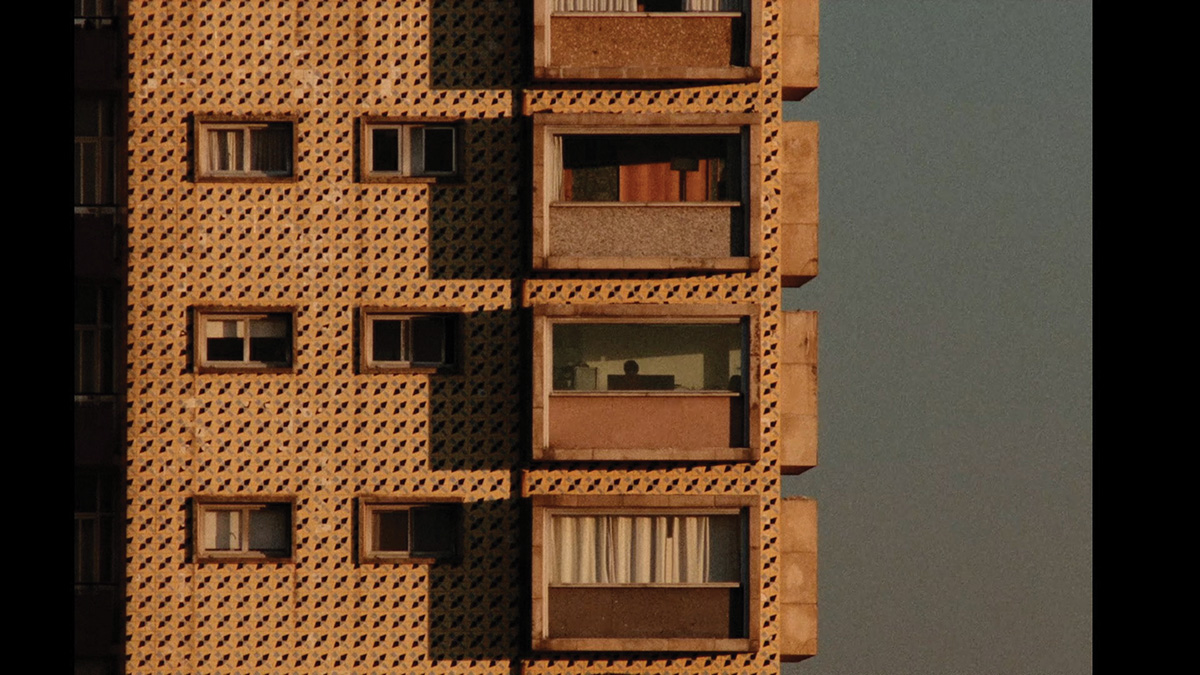

Rita Barbosa
2ª Pessoa
Vidéo | 4k | couleur | 16:0 | Portugal | 2022
One day, an old water pipe caused a ceiling leak. On this ceiling, toxic mushrooms of the order Polyporales would grow. Sitting on the toilet, the lady of this house looks up and observes that magical and mysterious fungus, which is not an animal, nor a plant. The mushroom is the future, she thought.
1979. Graduated in Digital Arts, in Sound and Image Course, by the School of Arts of UCP (2002). She completed her training with courses and workshops such as the Maine Media Workshops Photography Management Workshop. She wrote and performed her first short film FRIENDS AFTER DARK [2016], that had it international premiere at the 69th Locarno Film Festival, and was screened at film festivals such as Curtas de Vila do Conde, Márgenes, Curtas de Verin, SACO - Oviedo Contemporary Audiovisual Week, FICA - Aguilar del Campo Film Festival, Cinema Jove, Luso Brasileiro de Santa Maria da Feira, and in other exhibitions of which Bilbao Arte stands out. She wrote and staged the film-performance AMIGOS IMAGINÁRIOS [2018], with the collaboration of Rui Lima, Sérgio Martins and Jonathan Saldanha, with a premiere scheduled at Teatro Rivoli (2019). In theater, dance and performance she collaborated in the creation, set design, visual design, video and dramaturgy of several projects, including TRÊS DEDOS ABAIXO DO JOELHO (2012), by Tiago Rodrigues, that won Best Play in 2012 by the SPA, presented internationally in Kunsten Festival Des Arts, De Internationale Keuze and Rotterdamse Schouwburg, STAGE, Théâtre de la Ville, Théâtre des Abbesses, Emilia Romagna Theater Fondazione, among others. She collaborated in the plays: SABOTAGEM (2015), by Lígia Soares, Miguel Castro Caldas and Sílvia Pinto Coelho; O ESPLÊNDIDO (2014), by Andresa Soares. She participated also in other performance projects, such as CELEBRAÇÃO (2012), a dance and performance program presented at Culturgest. She is a TV commercial director for Take It Easy since 2006, where she has made severaladvertisements brand campaigns: Compal, Luso, Matinal, Gallo, Médis, Banco Popular, Terra Nostra, Lidl, CGD, Optimus, ANF, Staples, PT, TMN, Planta, Unitel, Milaneza, RTP, etc. She directed documentary and experimental videos such as: ESFORÇOZINHO DA GENICA, SKATE NO PALÁCIO, POP FISH e GET BENT [2005], this one presented at the exhibition "J'en Rêve" at the Cartier Foundation Paris and at the festivals Imago, Video-Lisboa, Impakt Festival and Courtisane.


Jessica Bardsley
Life Without Dreams
Doc. expérimental | 16mm | couleur et n&b | 13:30 | USA | 2022
LIFE WITHOUT DREAMS is set in the outer space of consciousness, where the surfaces of far-out planetary bodies form the terrain for an exploration of 24/7 capitalism, insomnia, and the disappearance of darkness due to light pollution.
Jessica Bardsley is an artist-scholar working across film, writing, and studio art. Her films have screened within the U.S. and internationally at festivals like CPH:DOX, Sundance, Visions du Réel, EMAF, RIDM, True/False, and on the Criterion Channel. She is the recipient of various awards, including a Princess Grace Award, Grand Prize at 25FPS, the Eileen Maitland Award at the Ann Arbor Film Festival, Best Short Film at Punto de Vista, and numerous Harvard Film Study Center fellowships. Her first feature film, The Cave Without a Name, was a finalist for the 2022-2023 Venice Biennale's Cinema College. Her research and writing have been supported by the Radcliffe Institute for Advanced Study, the Terra Foundation for American Art, and the Henry Luce Foundation/American Council of Learned Societies. She received a Ph.D. in Film and Visual Studies from Harvard University and an M.F.A. from the School of the Art Institute of Chicago. She is Assistant Professor of Experimental Film and Media at NYU's Tisch School of the Arts.
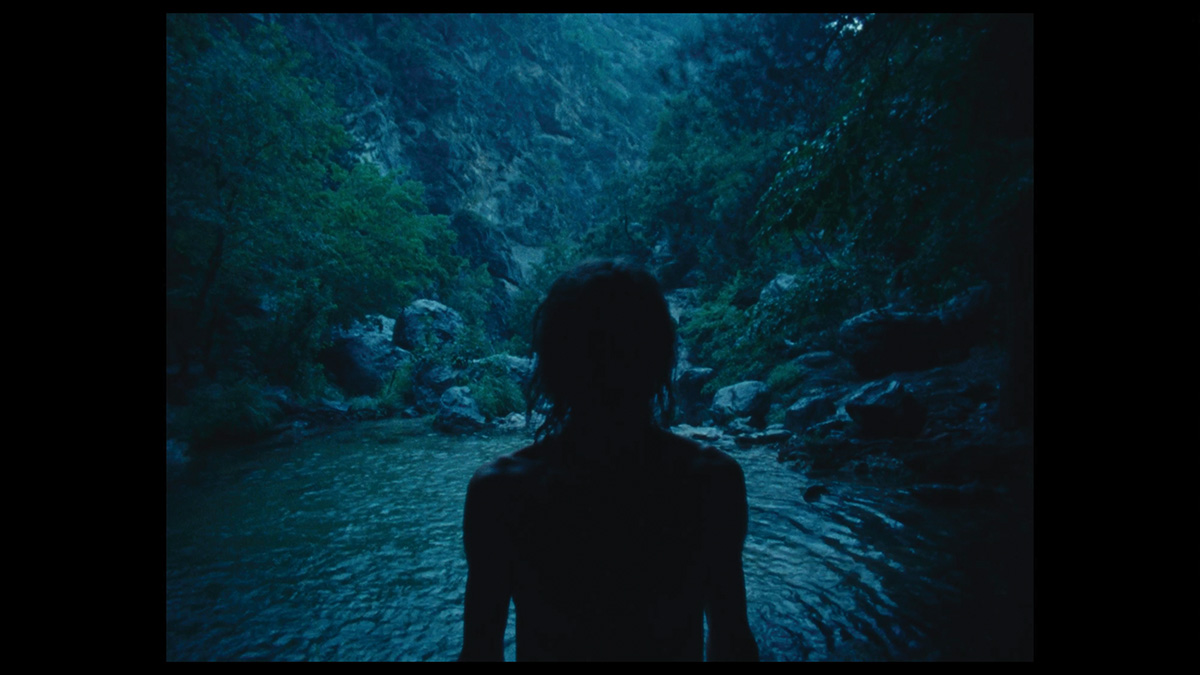

Felix Bartke, Nils Ramme
Herkules
Doc. expérimental | 16mm | couleur | 23:10 | Allemagne, Autriche | 2023
Hercules travels by bike from Krefeld in the Lower Rhine region to Mount Olympus, the throne of ancient deities. In the process, the legend of Hercules, as a primal myth of masculine power, is interrogated by means of biographical reflections and stagings of mythological echoes. The dramatic structure of this hero’s journey breaks up, in multi-material perspective, into issues of male identity, ideals and remorse.
Nils Ramme and Felix Bartke have been studying at the Academy of Media Arts Cologne since 2017. Since 2020 they share an artistic practice, which so far has resulted in the short films "Cruiser" (2022) and "Hercules" (2023). "Cruiser" has been shown internationally ( Internationale Kurzfilmtage Oberhausen; Clermont-Ferrand; St. Louis International Film Festival, Missouri, Landshuter Kurzfilmtage, FECI Bogota) and was awarded the "Queer- and Genderprice 2022" by the "blicke Filmfestival" (Bochum, Germany).


Anouch Basbous
[ Hatef Sada ] ???? ???
Film expérimental | mov | couleur et n&b | 7:30 | France | 2021
Une correspondance entre deux amant.es de deux villes méditerranéennes, une lettre interdite donnée à la mer pour qu'elle la porte. Le titre signifie phone echo, les échos de la voix.
Anouch Basbous est née à Marseille en 1999 et a grandi principalement à Berlin où elle a développé un intérêt pour la narration visuelle par la photographie. En 2018 elle va pour la première fois au Liban et c’est une rencontre qui la marque profondément, elle rentre en France avec un désir de faire des films. En 2022 est elle diplômée du DNA aux Beaux-arts de Marseille où elle réalise son premier film [ Hatef Sada ] ???? ???, dans lequel elle explore l'utilisation du hors-champ dans la narration d'une histoire d'amour queer au Liban, en collaboration avec Thery Alam, musicienne et artiste sonore libanaise. Anouch poursuit actuellement son master et travaille à l'élaboration d'un prochain film qui se déroule au Liban.
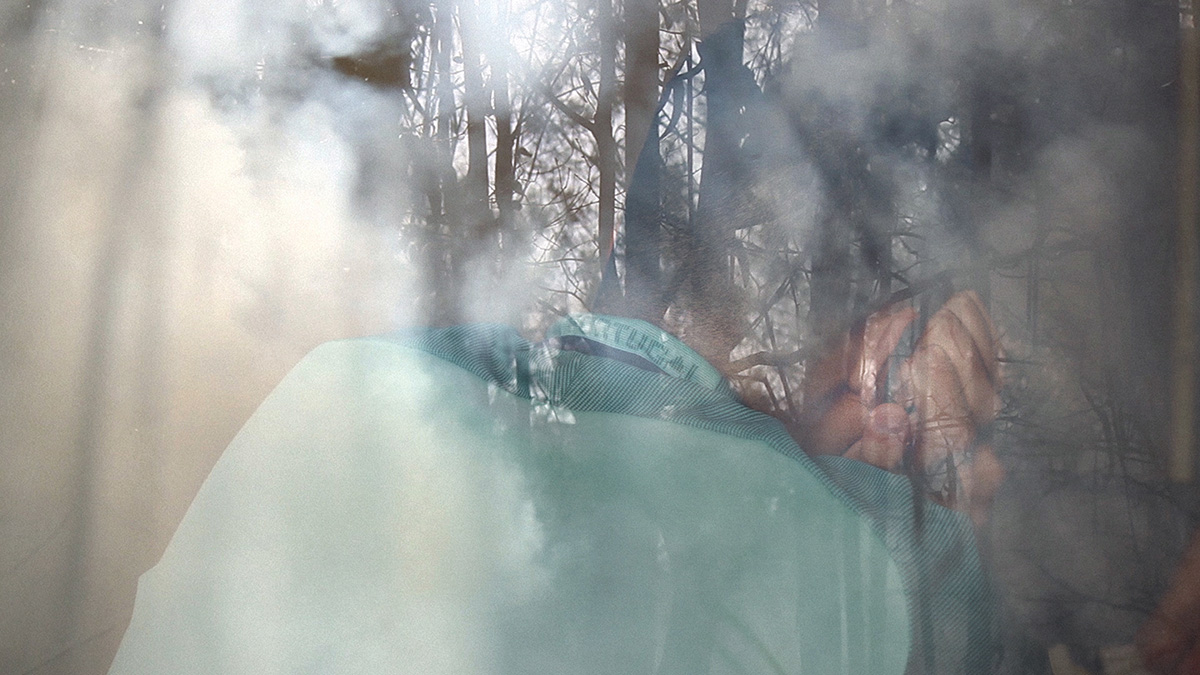

Angelin Battais
Nanterre Personne
Doc. expérimental | mov | couleur | 8:20 | France | 2019
Localisé à Nanterre dans l’appartement d’une famille originaire de la migration Portugaise de 1960, des proches se heurtent à une logique identitaire et l’épreuve de leurs désirs. S’additionnent une narration interpersonnelle et générationnelle entrelacées à un extérieur de la scène. Leurs visions se succèdent, l’aliénation, des fragments croisés et ceux hors champs d’une politique de l’intégration et de nouveaux points de décision.
Angelin est artiste franco- portugais·e, cinéaste, photographe et performeur résidant en France. Iel collabore avec la plateforme de cinéma expérimental Kinet.media (US) et co-dirige le label de musique expérimentale Hisolat sous le pseudonyme Abhr.
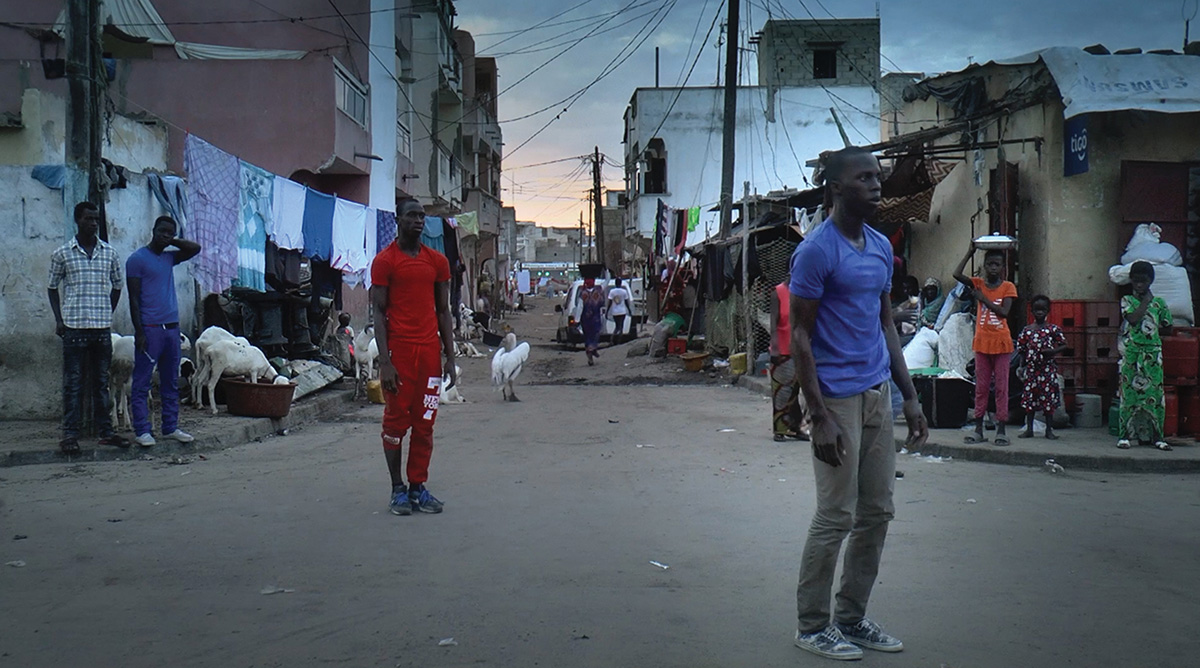

Kita Bauchet
Les Gestes de Saint-Louis
Doc. expérimental | 4k | couleur | 32:0 | Belgique, Sénégal | 2022
Fruit d’une collaboration entre la compagnie de danse contemporaine sénégalaise Diagn’art et les artistes belge et suisse Kita Bauchet et Stéphanie Pfister, « Les gestes de Saint-Louis » présente une esquisse subjective de la ville et du quotidien qui la rythme. Une infiltration chorégraphique de Saint-Louis à 2 danseurs et 2 caméras sur la musique de Siegfried Canto, qui met en lumière les énergies qui la font vibrer et célèbre la force créative de sa jeunesse.
Diplômée de l’INSAS, Kita Bauchet est une cinéaste belge. Après plusieurs courts métrages de fiction, elle réalise en 2009 La Fabrique de Panique, un long-métrage documentaire sur le film d’animation «Panique au village» de Vincent Patar et Stéphane Aubier, suivra en 2016 Une vie contre l’oubli sur l’œuvre du réalisateur André Dartevelle. En 2018, elle réalise Bains Publics, qui pousse les portes des « Bains du Centre » au cœur des Marolles, un quartier populaire de Bruxelles. Le film reçoit le prix France Télévisions du meilleur documentaire au Festival International de Films de Femmes à Créteil ainsi qu’au festival Brussels in Love, le Prix Birgit Wallborn de Docs en Goguette et une mention spéciale du jury au festival «Signes de vie à Clermont-Ferrand. En 2022, débute le parcours de « Les Gestes de Saint-Louis » mené en collaboration avec la compagnie de danse contemporaine Diagn’art, l’artiste suisse Stéphanie Pfister sur des musiques de Siegfried Canto.


Yann Beauvais
evanescent nsw
Film expérimental | 16mm | | 7:35 | France, Brésil | 2023
Document initialement filmé en 16mm dans la nouvelle galles du sud en août 97. Refilmé à la tireuse optique en modifiant la vitesse et l’aspect chromatique, puis laisser décomposer avec le négatif original pendant plusieurs années dans une autre région tropicale. La région a subit de nombreux incendies suite au changement climatique depuis l’époque ou je l’avais brièvement filmée. Le film fait écho à ces transformations dans sa matière même mais aussi avec des found footages et des sons divers.
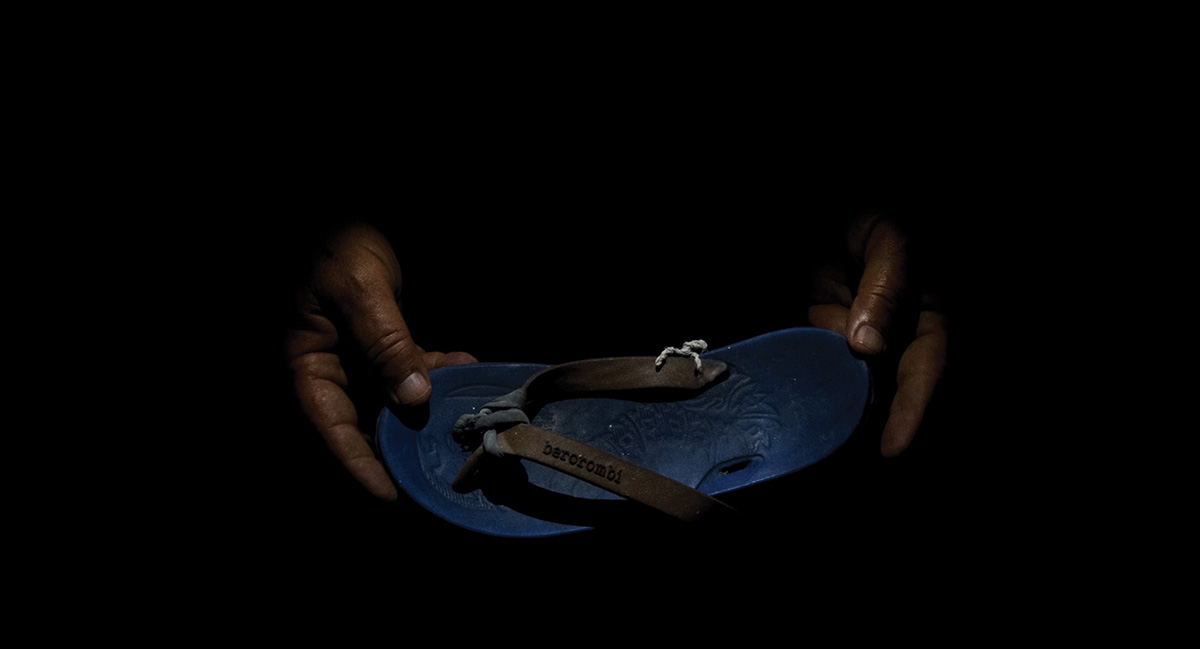

Younès Ben Slimane
We Knew How Beautiful They Were, These Islands
Doc. expérimental | hdcam | couleur | 20:0 | Tunisie, France | 2022
A lone figure digs a grave in the dead of night. With no dialogue – and no sound other than the wind, the crackling of a fire and the scrape of a shovel against dry earth – we are confronted with a dark and mysterious, possibly cursed, universe where every object seems haunted by a meaning we barely sense, but which seem to confirm our anxieties. The head of an old doll, a comb, a lipstick. Relics whose silent language speaks of the end of their former owners. At sea, in the desert. Younes Ben Slimane’s disturbingly beautiful and melancholic imagery is bathed in darkness and in a golden chiaroscuro, lit only by the stars and the lone grave diggers’ headlamps.
Younès Ben Slimane : Artiste et cinéaste tunisien, diplômé du Fresnoy – Studio national des arts contemporains en 2022. Ses films ont été sélectionnés dans des festivals internationaux parmi lesquels Locarno Film Festival, CPH:DOX, DokuFest, Festival dei Popoli. Il a reçu le a remporté le Tanit d'or aux journées cinématographiques de Carthage (2019), le Prix Studio Collector(2021) et le prix Loop Barcelona(2022).Son travail fait partie des collections d’institutions et de musées d’art notamment l’institut d'art contemporain, Villeurbanne/Rhône-Alpes (IAC), France et le Musée d'art contemporain de Barcelone, MACBA - Barcelone, Espagne. Actuellement, Younès Ben Slimane se consacre au développement de son prochain film grâce au programme Focus Script du Festival de Cannes.